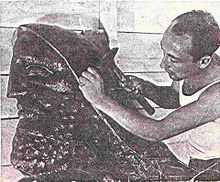Maurice Ascalon


Maurice Ascalon (1913–2003), was an Israeli designer and sculptor. He was, by some accounts, considered the father of the modern Israeli decorative arts movement.
Maurice Ascalon was born as Moshe Klein in eastern Hungary. From an early age, he was determined to pursue his artistic yearnings, however in order to do so, he was forced to abandon his ultra-religious Chasidic Jewish roots – for artistic expression was frowned upon in the eastern Hungarian “shtetl” in which he was raised. When he was 15 years old Klein left his family and boyhood home to study art at the Académie Royale des Beaux-Arts in Brussels. He took with him an in-depth understanding of the rituals and traditions of the Jewish ceremonies, which knowledge he would later apply to his artistic endeavors.
In 1934, after undertaking his formal artistic training in Brussels and later Milan, Maurice Ascalon immigrated to the land of Israel (then the British Mandate of Palestine). There he met his wife-to-be, Zipora Kartujinsky, a Polish-born Jew, granddaughter to the distinguished cartographer and scientist of the same surname. (Zipora, who died in 1982, became a sculptor in her own right late in her life, creating magnificent bas reliefs depicting the Shtetl life of her childhood).
In 1939, Maurice Ascalon designed and created the enormous 14-foot-tall (4.3 m) hammered repoussé copper relief sculpture of three figures, "The Toiler of the Soil, the Laborer and the Scholar", which adorned the façade of the Jewish Palestine Pavilion of the 1939 New York World's Fair. Ascalon was commissioned to create this work for the historically significant Pavilion which introduced the world to the concept of a modern Jewish state. (The work is now part of the collection of the Spertus Museum in Chicago.)
In the late 1930s, Ascalon founded an Israeli decorative arts manufacturing company, Pal-Bell, which produced trademark bronze and brass menorahs and other Judaic and secular decorative art and functional items that were exported in large numbers worldwide. Maurice Ascalon's well-recognized designs, some art deco, others more traditional, introduced the use of a deliberate, chemically induced green patina (verdigris) to Israeli metalwork, which is now a hallmark of Israel's crafts industry. During Israel's War for Independence in 1948, Maurice designed munitions for the Israeli Army and, at the request of the Israeli government, retrofitted his factory to produce munitions for the war effort. In 1956 Maurice immigrated to the United States.
During the latter part of the 1950s through the 1960s, Maurice resided in New York and Los Angeles. He gained a reputation as a master silversmith, creating for synagogues magnificent Torah crowns and other l objects of Jewish ceremonial art that he first learned of in his youth. For a time, he taught sculpture on the fine arts faculty of the University of Judaism (now the American Jewish University) in Los Angeles.
In the late 1970s, Maurice’s workshop, now formally dubbed Ascalon Studios, relocated to the Philadelphia area. It became (and still is today, under the direction of Maurice’s son, David Ascalon) a multifaceted art studio dedicated to the design of and creation of site-specific art for worship and public spaces.
In February 2003, Maurice Ascalon celebrated his 90th birthday as a resident of Cuernavaca, Mexico, where he lived with his eldest son, Adir Ascalon (Adir was a surrealist painter and sculptor who collaborated with the noted Mexican muralist David Alfaro Siqueiros). In August 2003, Maurice Ascalon succumbed to complications related to Parkinson's Disease, an illness he endured during most of the final decade of his life.
Maurice Ascalon’s commissions include permanent installations at worship and public spaces throughout the United States, Mexico, and Israel. His works have been exhibited at and are among the collections of institutions including the Jewish Museum (New York), the Museum of American Jewish History in Philadelphia, the Spertus Museum in Chicago, the Eretz Israel Museum in Tel Aviv, and the University of Judaism in Los Angeles.
Bibliography
- Schwarz, Jessica; Ha'tell, Aaron (21 June 2010). A Celebration of Light: Treasured Hanukkah Menorahs of Early Israel. Lulu Enterprises Inc. ISBN 978-0-557-13711-4. Retrieved 20 June 2011.
- Bull, Donald A. (2009). Figural Corkscrews. Schiffer Publishing Ltd. ISBN 978-0-7643-3315-6. Retrieved 20 June 2011.
- Ha'Tell, Aaron; Ha'tell, Ari; Ben Or, Yaniv (November 2006). Lighting the way to freedom: treasured Hanukkah menorahs of early Israel. Devora Publishing. ISBN 978-1-932687-66-8. Retrieved 20 June 2011.
- Kenaan-Kedar, Nurit (2006). Modern creations from an ancient land: metal craft and design in the first two decades of Israel's independence, from the collection of Vicky Ben-Zioni. Yad Izhak Ben-Zvi/ Eretz Israel Museum/ Tel Aviv University. Retrieved 20 June 2011. ISBN 965-217-256-1
- Braunstein, Susan L. (2004). Five centuries of Hanukkah lamps from the Jewish Museum: a catalogue raisonné. Jewish Museum (New York, N.Y.). ISBN 978-0-300-10623-7. Retrieved June 20, 2011.
- Braunstein, Susan L. (2004). Luminous art: Hanukkah menorahs of the Jewish Museum. Jewish Museum, under the auspices of the Jewish Theological Seminary of America. ISBN 978-0-300-10387-8. Retrieved 20 June 2011.
- Aisenberg, Lydia (November 30, 2007). "Enlightening". The Jerusalem Post. Retrieved June 20, 2011.
- “New Jersey Artist Honored Posthumously in Tel Aviv” New Jersey Jewish News, December 15, 2005 at 50.
- "Jews Who Died in 2003". Jewish Telegraphic Agency. January 2, 2004.
- “In the Frame” by Gil Goldfine, The Jerusalem Post, August 15, 2003 p.B14.
- “Sculptor Maurice Ascalon Dies” by Barbara Rothschild, The Courier-Post, August 7, 2003 at B1.
- “M. Ascalon Maker of Judaic Art”, The Philadelphia Inquirer, August 5, 2003.
See also
- David Ascalon
- Brad Ascalon
External links
| Wikimedia Commons has media related to Maurice Ascalon. |
- Maurice Ascalon's Pal-Bell Co. Ltd.
- Bio and Transcript of Eulogy for Maurice Ascalon
- Pal-Bell Online Collectors Forum